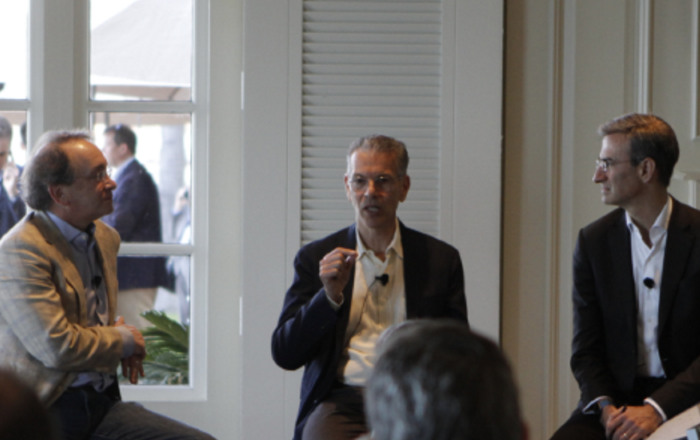How will new entrants—companies that have not traditionally driven healthcare delivery or payment—transform the healthcare market in next few years? At the Health Evolution Summit, two physicians representing prominent new entrants explored the impact of new market forces.
David Feinberg, vice president of Google Health addressed AI and Alan Lotvin executive vice president of transformation for CVS Health, considered the impact of vertical integration during an Impact Circle discussion hosted by Peter Orszag, managing director Lazard and director of the Office of Management and Budget under President Obama.
At the leading edge of tech, Feinberg walked listeners through the familiar Google search all the way to an AI algorithm that noticed a hitherto undiscovered difference between male and female retinas.
Currently, Google users search for answers to health questions a billion times a day, and get millions and millions of results. But with just a little bit more information, Feinberg says, those results could easily be refined to exactly what the searcher needs. “For example, if you typed in ‘bloating,’ and there were a couple of choices: male or female? Are you talking about yourself? Are you pregnant? Is this an elderly person or a baby? With just a few pieces of information, we could collate the results better for you.” The next refinement of that approach might, with proper consent, tie into user’s health history and further customize the results.
That refinement could also help clinicians understand their patient’s concerns, Feinberg noted. “I had patients come in with the whole Internet, or they had searched enough to find the answer they wanted: that bee pollen would cure their schizophrenia.”
Because Google can search so many data sources, it has access to more data than the CDC or your local public health department, Feinberg said. “We can tell you who has Lyme disease with accuracy that’s as high as the CDC, “ but is two years earlier. Google can identify restaurants associated with cases of food poisoning with about 85 percent accuracy. “Now we’ve got to figure out how to do those things and not be creepy.”
On the provider side, Google can apply artificial intelligence to the analysis of medical record data or images and predict what’s going to happen to a patient’s health in the next six months with about 98 percent accuracy, Feinberg said. “We can say, ‘Hey, if you want to go to your kid’s graduation, you have to make these changes,’” to stay healthy and out of the hospital.
As part of a screening program for diabetic retinopathy, Google researchers applied an AI algorithm to a large number of retina images collected during a free screening program in India. An intern was assigned to see how well the algorithm identified certain variables just by looking at the images. It turned out that the algorithm could distinguish a male patient from a female patient about 75 percent of the time, even though ophthalmology doesn’t recognize any fundamental differences between male and female retinas.
“If there’s a picture in medicine, our computers can do better than doctors,” Feinberg said. “Now we have to figure out how to get it into the workflow. We don’t want to replace the docs.”
Meanwhile, back at the corner pharmacy, there are equally radical changes courtesy of CVS Health, where Alan Lotvin hopes to create a primary care infrastructure for people who normally don’t “go to the doctor.” About 85 percent of the U.S. population lives within four miles of a CVS, which could use its MinuteClinics not only for school physicals, flu shots and ear infections, but also to manage diabetes or asthma.
“We are not trying to replace primary care,” Lotvin clarified. “We are working with primary care doctors so there’s an off-ramp when people get too sick.” About half the people who use MinuteClinics don’t have a primary care doctor, Lotvin said. “And what’s interesting to me is that half of those don’t want one.” For those that do, the clinics provide referrals: 3.4 million in the past year alone.
CVS is building several new MinuteClinics specifically to manage patients with chronic diseases in areas that it has identified as “primary care deserts.” It’s using pharmacists and nurse practitioners at the top of their licenses to handle the bulk of routine care for patients at high risk of a health crisis, with physician practices as a backstop. “Doctors don’t like taking phone calls from Caremark or Medco or Express Scripts, but they’re very happy to take a call from the local pharmacist,” Lotvin said.
Each pharmacist was given a panel of 170-200 patients with chronic illnesses, and the clinics were equipped appropriately to do a thorough exam: blood and urine tests, blood pressure, and retina cameras to check eye health. The pharmacists reached out to each patient to address specific gaps in care, and about 70 percent of the time were successful in getting them on some type of care regimen.
“I talked to a lot of health systems, and I don’t know anyone who’s got a surfeit of primary care doctors,” Lotvin said. “So you’d rather have your primary care doctors seeing highly complex cases instead of titrating blood pressure and titrating cholesterol drugs. We can help do that and everything done in MinuteClinic flows right into the Epic [EMR].”
And on the prevention side? Healthier snacks. “You walk down the center aisle and the first thing you come across is kale chips,” Lotvin said. “We’ve really tried to reset the store to be much more conducive to helping people make good choices.”











